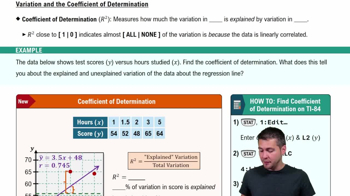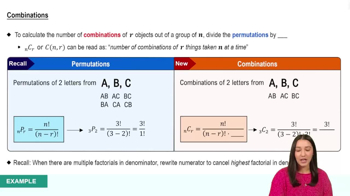20. Skating Eight people compete in a short track speed skating race. Assuming that there are no ties, in how many different orders can the skaters finish?
Table of contents
- 1. Intro to Stats and Collecting Data1h 14m
- 2. Describing Data with Tables and Graphs1h 55m
- 3. Describing Data Numerically2h 5m
- 4. Probability2h 16m
- 5. Binomial Distribution & Discrete Random Variables3h 6m
- 6. Normal Distribution and Continuous Random Variables2h 11m
- 7. Sampling Distributions & Confidence Intervals: Mean3h 23m
- Sampling Distribution of the Sample Mean and Central Limit Theorem19m
- Distribution of Sample Mean - Excel23m
- Introduction to Confidence Intervals15m
- Confidence Intervals for Population Mean1h 18m
- Determining the Minimum Sample Size Required12m
- Finding Probabilities and T Critical Values - Excel28m
- Confidence Intervals for Population Means - Excel25m
- 8. Sampling Distributions & Confidence Intervals: Proportion1h 12m
- 9. Hypothesis Testing for One Sample3h 29m
- 10. Hypothesis Testing for Two Samples4h 50m
- Two Proportions1h 13m
- Two Proportions Hypothesis Test - Excel28m
- Two Means - Unknown, Unequal Variance1h 3m
- Two Means - Unknown Variances Hypothesis Test - Excel12m
- Two Means - Unknown, Equal Variance15m
- Two Means - Unknown, Equal Variances Hypothesis Test - Excel9m
- Two Means - Known Variance12m
- Two Means - Sigma Known Hypothesis Test - Excel21m
- Two Means - Matched Pairs (Dependent Samples)42m
- Matched Pairs Hypothesis Test - Excel12m
- 11. Correlation1h 6m
- 12. Regression1h 50m
- 13. Chi-Square Tests & Goodness of Fit1h 57m
- 14. ANOVA1h 57m
4. Probability
Counting
Problem 3.4.31
Textbook Question
31. Experiment A researcher is randomly selecting a treatment group of 10 human subjects from a group of 20 people taking part in an experiment. In how many different ways can the treatment group be selected?
 Verified step by step guidance
Verified step by step guidance1
Step 1: Recognize that this is a combination problem because the order in which the subjects are selected does not matter. The formula for combinations is given by: , where is the total number of items, and is the number of items to choose.
Step 2: Identify the values of and . Here, (total number of people) and (number of people to select).
Step 3: Substitute the values of and into the combination formula: .
Step 4: Simplify the denominator by calculating , which equals . The formula now becomes: .
Step 5: Cancel out the common terms in the numerator and denominator, and compute the remaining terms to find the number of ways the treatment group can be selected. This involves dividing the factorial of 20 by the product of two factorials of 10.
 Verified video answer for a similar problem:
Verified video answer for a similar problem:This video solution was recommended by our tutors as helpful for the problem above
Video duration:
1mPlay a video:
Was this helpful?
Key Concepts
Here are the essential concepts you must grasp in order to answer the question correctly.
Combinatorics
Combinatorics is a branch of mathematics dealing with combinations and permutations of objects. It provides the tools to count the number of ways to select items from a larger set without regard to the order of selection. In this context, it helps determine how many different groups of 10 can be formed from a total of 20 subjects.
Binomial Coefficient
The binomial coefficient, often denoted as 'n choose k' or C(n, k), represents the number of ways to choose k elements from a set of n elements without considering the order. It is calculated using the formula C(n, k) = n! / (k!(n-k)!), where '!' denotes factorial. This concept is essential for solving the problem of selecting the treatment group.
Recommended video:
Guided course

Coefficient of Determination
Factorial
A factorial, denoted as n!, is the product of all positive integers up to n. It is a fundamental concept in combinatorics used to calculate permutations and combinations. In the context of this question, factorials are used in the binomial coefficient formula to compute the total number of ways to select the treatment group from the available subjects.
Recommended video:

Combinations

 7:11m
7:11mWatch next
Master Introduction to Permutations with a bite sized video explanation from Patrick
Start learningRelated Videos
Related Practice
Textbook Question
